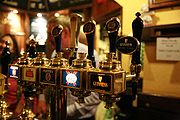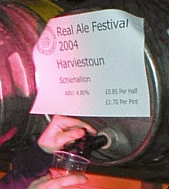
Beer tap
Encyclopedia

Valve
A valve is a device that regulates, directs or controls the flow of a fluid by opening, closing, or partially obstructing various passageways. Valves are technically pipe fittings, but are usually discussed as a separate category...
, specifically a tap
Tap (valve)
A tap is a valve controlling release of liquids or gas. In the British Isles and most of the Commonwealth, the word is used for any everyday type of valve, particularly the fittings that control water supply to bathtubs and sinks. In the U.S., the term "tap" is more often used for beer taps,...
, for controlling the release of beer
Beer
Beer is the world's most widely consumed andprobably oldest alcoholic beverage; it is the third most popular drink overall, after water and tea. It is produced by the brewing and fermentation of sugars, mainly derived from malted cereal grains, most commonly malted barley and malted wheat...
. While in other contexts, depending on location, a "tap" may be a "faucet", "valve" or "spigot", the use of "tap" for beer is almost universal
Universal (metaphysics)
In metaphysics, a universal is what particular things have in common, namely characteristics or qualities. In other words, universals are repeatable or recurrent entities that can be instantiated or exemplified by many particular things. For example, suppose there are two chairs in a room, each of...
. This may be because the word was originally coined for the wooden valve in traditional barrel
Barrel
A barrel or cask is a hollow cylindrical container, traditionally made of vertical wooden staves and bound by wooden or metal hoops. Traditionally, the barrel was a standard size of measure referring to a set capacity or weight of a given commodity. A small barrel is called a keg.For example, a...
s. Beer served from a tap is largely known as draught beer
Draught beer
Draught beer is beer served from a cask or a pressurised keg.-History of draught:Until Joseph Bramah patented the beer engine in 1785, beer was served directly from the barrel and carried to the customer. The Old English word for carry was dragen which developed into a series of related words,...
, though beer served from a cask is more commonly called cask ale
Cask ale
Cask ale or cask-conditioned beer is the term for unfiltered and unpasteurised beer which is conditioned and served from a cask without additional nitrogen or carbon dioxide pressure...
, while beer from a keg may specifically be called keg beer.
There are many different types of beer or keg taps.
There are also many styles of beer taps.
Pressure-dispense bar tap
Almost universally in modern times, bulk beer is supplied in kegKeg
A keg is a small barrel.Traditionally, a wooden keg is made by a cooper used to transport items such as nails, gunpowder., and a variety of liquids....
s that are served with the aid of external pressure. In a normal bar dispense system, this pressure comes from a cylinder of carbon dioxide
Carbon dioxide
Carbon dioxide is a naturally occurring chemical compound composed of two oxygen atoms covalently bonded to a single carbon atom...
(or occasionally nitrogen
Nitrogen
Nitrogen is a chemical element that has the symbol N, atomic number of 7 and atomic mass 14.00674 u. Elemental nitrogen is a colorless, odorless, tasteless, and mostly inert diatomic gas at standard conditions, constituting 78.08% by volume of Earth's atmosphere...
) which forces the beer out of the keg and up a narrow tube to the bar. At the end of this tube is a valve built into a fixture (usually somewhat decorative) on the bar. This is the beer tap, and opening it with a small lever causes beer, pushed by the gas from the cylinder, to flow into the glass.
Portable keg tap
Sometimes, beer kegs designed to be connected to the above system are instead used on their own, perhaps at a party or outdoor event. In this case, a self-contained portable tap is required that allows beer to be served straight from the keg. Because the keg system uses pressure to force the beer up and out of the keg, these taps must have a means of supplying it. The typical "picnic tap" uses a hand pump to push air into the keg; this will cause the beer to spoil faster but is perfectly acceptable if the entire keg will be consumed in a short time. Portable taps with small CO2 cylinders are also available.Cask beer tap

Cask ale
Cask ale or cask-conditioned beer is the term for unfiltered and unpasteurised beer which is conditioned and served from a cask without additional nitrogen or carbon dioxide pressure...
, do not use artificial gas. Taps for cask beer are simple on-off valves that are hammered into the end of the cask (see keystone
Keystone (cask)
A keystone is a small wooden or plastic fitting used in ale casks.For some years wooden casks have been effectively obsolete, with the majority now being aluminium or stainless steel, and a few sturdy plastic ones beginning to appear. Nevertheless, the standard tap is still designed to be hammered...
for details). When beer is served directly from the cask ("by gravity"), as at beer festival
Beer festival
A Beer Festival is an organised event during which a variety of beers are available for tasting and purchase. Beer festivals are held in a number of countries...
s and some pubs, it simply flows out of the tap and into the glass. When the cask is stored in the cellar and served from the bar, as in most pubs, the beer line is screwed onto the tap and the beer is pulled through it by a beer engine
Beer engine
A beer engine is a device for pumping beer, originally manually operated and typically used to dispense beer from a cask or container in a pub's basement or cellar. It was invented by the locksmith and hydraulic engineer Joseph Bramah in 1797...
. The taps used are the same, and in beer-line setups the first pint is often poured from the cask as for "gravity", for tasting, before the line is connected. Cask beer taps can be brass (now discouraged for fear of lead contamination), stainless steel, plastic, and wood.
In Scotland, cask ale was traditionally served through a tall fount. These appear similar to keg taps (indeed, many Scottish pubs serve keg beer through adapted tall founts) rendered from brass but the beer was drawn from the barrel via air pressure generated by a water engine rather than by a pressurised artificial gas. Some pubs still dispense cask beer using this method (although the water engine will invariably have been replaced by an electric compressor) but is increasingly rare due to the perception that hand-pumps are the 'correct' means by which to serve real ale, and to the potential for confusion with keg ale, which is regarded as inferior by many beer drinkers.
Dimensions
Typical tap handles are 9-13" tall, but can range from very short (4") to novelty lengths (>13"). Most taps are assembled with a 4" delrin handle.The threading for tap handles is 3/8"-16 UNC (coarse). The faucet is male and the handle is female.

